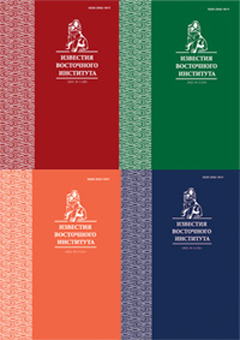Требования к рукописям
- Формат файла должен быть совместим с Microsoft Office Word.
- Файл не должен содержать встроенных стилей и специального форматирования.
- Формат страницы A4. Поля страницы: верхнее и нижнее – 2 см, правое – 1,5 см, левое – 2,5 см.
- В заголовках не применять ЗАГЛАВНЫЕ символы без необходимости, простановка буквы «ё» в тексте рукописи обязательна.
- Шрифт Times New Roman, размер знака 14 пт, межстрочный интервал 1,5.
- Объём основного текста присылаемых рукописей (без учета аннотаций и списка литературы):
статей – от 0,5 до 1,0 авторского листа (20–40 тыс. знаков с пробелами); материалов в рубрику «Научная жизнь» – не более 0,3 авт. листа (12 тыс. знаков); комментариев к историческому источнику (в рубрику «Архив») – не более 0,3 авт. листа (12 тыс. знаков), текст исторического источника не должен превышать 1,0 авт. листа (40 тыс. знаков); материалов в рубрику «Рецензии» – не более 0,5 авт. листа (20 тыс. знаков).
- Порядок оформления статьи: УДК, Ф. И. О. автора (авторов) на русском языке и их транслитерация латиницей, название статьи (на русском и английском языках), аннотация (на русском и английском языках), ключевые слова (на русском и на английском языках), текст статьи, список использованной литературы, список сокращений (если есть), подписи к рисункам и диаграммам (если есть), информация об авторе (авторах) на русском и английском языках.
- Аннотация должна включать информацию о предмете, методологии и результатах исследования. Объём аннотации на русском языке – 500 (±100) знаков, на английском языке – 1000 (±100) знаков.
- Количество ключевых слов и фраз 5–7, количество слов внутри ключевой фразы не более 3 – так, чтобы общее количество слов не превышало 15. Ключевые слова должны быть упорядочены – от общих, соответствующих проблеме, к частным, отражающим детали исследования, методику.
- Текст рукописи может включать не более двух уровней заголовков.
- Ссылки в тексте статьи являются внутритекстовыми и оформляются квадратными скобками. В скобках сначала указывается порядковый номер цитируемой работы в списке литературы, затем, через запятую, номер страницы приведённой цитаты или упомянутого факта. В случае одновременной ссылки на несколько работ, сами ссылки помещаются внутрь одной пары скобок и отделяются друг от друга точкой с запятой.
- Ссылка на неопубликованный архивный или иной документ внутритекстовая, она не помещается в список литературы. Такая ссылка оформляется круглыми скобками.
- В случае, если рукопись включает таблицы, иллюстрации, диаграммы, в тексте должны быть ссылки на эти объекты.
- Таблицы, иллюстрации, диаграммы должны снабжаться поясняющей подписью, в которой дается название/заголовок и указывается авторство или источник происхождения: ссылка на элемент списка литературы, неопубликованный источник, иная ссылка.
- В силу того, что изображения в текстовый файл не вставляются, поясняющие подписи к иллюстрациям помещаются после списка литературы особым списком (даже если иллюстрация одна). Все подписи к иллюстрациям необходимо сопровождать переводом на английский язык.
- Рисунки, карты и т. п. принимаются в наиболее распространённых графических форматах (eps, ai, jpeg, bmp, tif) отдельными файлами с разрешением 300–450 dpi; вставлять графический файл в текстовый не следует!
- Имя графического файла с иллюстрацией – порядковый номер иллюстрации в рукописи.
- Диаграммы должны быть представлены в исходном виде, а не как рисунок, т. е. сопровождаться таблицей данных. Для этого диаграммы необходимо выполнять и предоставлять в формате электронных таблиц Microsoft Excel. Каждая диаграмма должна быть расположена на отдельном листе файла электронной таблицы.
- Ввиду чёрно-белой печати журнала цветовая гамма иллюстраций, графиков, карт и т. д. по возможности не должна содержать более трёх цветов (чёрный, белый, серый 50%).
- Расшифровка сокращений и аббревиатур (кроме общепринятых, ГОСТ Р 7.0.12-2011) обязательна и даётся в конце текста рукописи после списка литературы.
- Нумерованный список литературы составляется в алфавитном порядке, по фамилиям первых авторов и названиям работ без учёта соавторов и хронологии.
- В списке сначала указывается литература на кириллице, затем на латинице, затем в других системах письма.
- В одном пункте списка литературы не может больше одной ссылки на один том издания.
- Библиографическое описание элементов списка литературы выполняется по ГОСТу Р7.0.100–2018 «Библиографическая запись. Библиографическое описание. Общие требования и правила составления» (см. образец оформления рукописи).
- Ссылка на работу, опубликованную на восточном языке, должна включать описание на языке оригинала и полный перевод описания данной публикации на русский язык.
- При наличии у цитируемой публикации идентификатора цифрового объекта (DOI), его необходимо указывать.
- Русскоязычный список литературы должен сопровождаться его англоязычной версией («References»). В «References» после полного перевода описания неанглоязычной публикации на английский должен быть указан ее оригинальный язык. Например: (In Russian). Порядок расположения публикаций в списке литературы и «References» идентичен. Транслитерация неанглоязычных имен и фамилий выполняется по стандарту BSI (British Standards Institution).
- Сведения об авторе (авторах) рукописи должны включать: фамилию, имя, отчество, учёную степень, учёное звание, место работы, должность, адрес электронной почты, ORCID (при наличии).
- Присылаемому файлу (файлам) следует присваивать только фамилию автора (первого автора). В случае, если рукопись имеет нескольких авторов, редакция ведёт переписку с первым автором.
- Материалы предоставляются в редакцию в электронном виде без архивации в виде набора файлов. Адрес электронной почты: izvestyavi@yandex.ru
Обращаем внимание авторов, что рукописи статей, подготовленные с нарушением вышеуказанных требований, редакцией к рассмотрению не принимаются.




